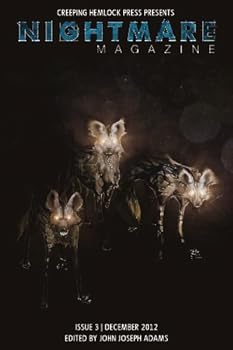 The third issue of Nightmare is more accomplished than one would expect from a magazine so new. The choice of stories is excellent, and the debut story is especially disturbing.
The third issue of Nightmare is more accomplished than one would expect from a magazine so new. The choice of stories is excellent, and the debut story is especially disturbing.
That debut is “Chop Shop” by J.B. Park, and if it is any indication, Park is going to have a brilliant career as a horror writer. The viewpoint character is a woman who has a horrifying sexual fetish: she is turned on by a man cutting away her flesh, her limbs, her organs slowly but surely. She is able to experience this because a virtual reality program makes it so, allowing her to feel pain that is dulled by drugs but still real, real enough to cause her a “joy” that is “absolutely delicious.” But it’s not really the pain that gives her a high; “it’s the horror, at the mangling, the crippling, which she seeks.” Quickly — much too quickly — the experience palls, for her but even more for her partner, an anonymous male with a skilled touch with a bone saw. He was attracted, not to her profile, but to her virginity; not her sexual virginity, but the fact that she had never been mutilated before. And she is still a virgin to mutilation, in the real world. Will she remain so? The story echoes Peter Straub’s recent novella, The Ballad of Ballard and Sandrine in theme; astonishingly, it is nearly as assured in its writing. One is repulsed, even sickened, but cannot look away.
Sarah Pinborough’s “The Nowhere Man” tells the story of Ben, a 12-year-old boy whose 15-year-old sister has vanished, leaving him with a terrible mother and no father. Ben does not believe that Amy would have left him alone with their dying shrew of a mother had she had any choice in the matter, but no one else believes that; they all think that Amy ran away. Ben stays away from his home as much as he can after Amy disappears, avoiding his mother’s illness and her nurse and her temper, hanging out with his friends, whom he anticipates will not be his friends for much longer as they slouch toward becoming teenagers: “That crazy teenage stuff took hold and real things didn’t matter anymore.” One day they see a man walking across the school sports fields carrying a machete. He strikes them as weird, not just because of the machete. Who is the man, and what does he mean to them? What does he know about Amy? The ambiguous ending makes the story unforgettable.
It isn’t unusual for a horror story to be set in winter; the cold and quiet of the world when green growing things are slumbering seems the natural environment in which evil can take hold. But Tananarive Due’s “Summer” finds horror in fecundity. Danielle’s baby Lola is a troublesome, unlovable child; or at least Danielle perceives her that way, and it may just be that Danielle is a bad mother with insufficient patience. Danielle isn’t sure which it is, but she is sure that she misses her husband, who is away for military training. Lola seems to take a positive joy in causing actual, physical pain to Danielle; she’s a flat-out hateful child, a “truth nobody wanted to hear.” Perhaps it’s the fault of the nearby swamp; maybe it’s the fact that it’s summer. All Danielle knows is that her baby is so utterly unpleasant she’s not sure she can love her. Help, or at least the appearance of it, comes from an unexpected quarter. This is one of the most unusual horror stories I’ve ever read, one in which reality seems more horrific than a supernatural possession. It’s a nice twist.
“Foul Weather” by Daniel H. Wilson rounds out the fiction for this issue. The first person narrator is a meteorologist who always takes the window seat when he flies in order to watch the weather. On one flight, a “magnificent” storm, a “towering armada of cumulonimbus clouds, plowing over the sea in battle formation,” overtakes the plane. It’s an evil storm, it seems, putting evil thoughts into the heads of those passengers who aren’t reduced to tears of fear. It does evil to the plane, too, and Wilson’s description of the results touches the visceral fear of flying that nests in many of us.
“The ‘H’ Word,” the recurring column by R.J. Sevin, is, appropriately enough for a December issue, about Christmas ghost stories, seguing into a discussion of what Sevin calls “comeuppance fantasies.” Sevin invites further discussion on the magazine’s website. The artist gallery features the digital art of Justin Cherry; if you purchase this magazine to read on an e-reader, be sure to visit the magazine’s website from a large color screen in order to properly appreciate the art. The interview with the artist is interesting, but I was more taken with the interview of Mike Mignola, the author of the “Hellboy” comic; now I want to rent the Hellboy movies, directed by Guillermo del Toro, as well as read the comic. The issue is rounded out by the usual author spotlights, an editorial and coming attractions.



Wow, I'm really impressed by the 15- and 20-year old owning and running their own bookstores! I loved books as…
There were two interesting articles about publishing that I ran across, the first via a link in the second: No…
My pleasure, Robin! And yes, it surely is some kind of an experience, to be sure....
Thanks for the solution to a mystery many decades old. One of my favourite novels, this. Hilariously funny, completely unpredictable,…
Thank you. I’m all caught up. Back to reading Crimson Embers.